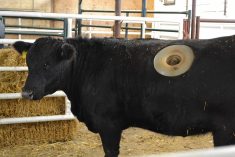Canadian producers returning from a United States beef conference are no wiser about how their industry will be affected by possible American tariffs, said the past-president of the Canadian Cattle Association (CCA). It wasn’t, however, for lack of effort.
“Absolutely nobody knows what’s going to happen,” said Bob Lowe, also president of the Global Roundtable for Sustainable Beef. “We’re awfully thankful we got a 30-day reprieve, but at the end of the 30 days what happens? Absolutely nobody is making any predictions.”
The Canadian beef industry was out in force at the National Cattlemen’s Beef Association’s CattleCon conference in San Antonio, Texas Feb. 4-6.
Read Also

The long march to autonomy
The big players in the machinery market keep adding pieces towards autonomous vehicles for farming, but how far away is a final product?
That put the conference’s opening on tariff day—the day set out by U.S. President Donald Trump as the point that 25 per cent tariffs would come into effect against Canadian and Mexican goods.
When the day dawned, however, Canadian representatives had less reason to be dour than expected. After last-minute deals, Trump announced a 30-day pause in the levies.
While a short-term relief to the beef sector, as well as the rest of Canadian agriculture, the delay did not dissipate industry or offer answers on how producers can protect themselves from the fallout when the 30 days is up.
“We export 50 per cent of our production and 70 per cent of that goes to the U.S.,” Lowe noted. “They are far and above our biggest market. If you put a 25 per cent tariff on that, it hurts. Well, it’s devastating, actually.”
Canada exported nearly 578,000 head of cattle to the U.S. between Jan. 1 and Nov. 30, 2024, a 17 per cent jump from 2023, according to the Canadian Food Inspection Agency.

In it together
The Canadian industry hoped the conference would help them continue their outreach to their U.S. partners, as well as grab the ear of U.S. national and state representatives. The beef sector is among those Canadian agriculture industries hoping that U.S. industry can more effectively impact tariff policy decisions in the U.S.
Lowe said NCBA officials at the conference understood the negative effect tariffs would have on the integrated industry where cattle, feed and processed products cross the border each day.
“The NCBA agrees with trade as much as we do. Everybody says we need trade that is open and fair and science-based trade. Whether that actually gets to happen, or not, is a different story.”
CCA president Nathan Phinney said, despite the 30-day reprieve, officials know they must continue to work together and speak be unified in their message about the importance of an integrated industry.
“The NCBA is 100 per cent supportive of our relationship and collaborating and working together as an industry. They are just dealing with a tough administration that is in power. Three weeks into the presidency and everybody is just trying to navigate how to deal with this,” he said.
Steve Kay, the California-based publisher and editor of Cattle Buyers Weekly, has seen those pro-trade lobbying efforts when U.S. cattle and meat groups approach Congress.
“The National Cattlemen’s Beef Association and the Meat Institute, which represents meat and poultry processors and other groups, [and the] American Farm Bureau Federation are working furiously, probably 24 hours a day, to directly lobby the White House not to put on tariffs on agricultural products,” he noted.
“And they will be making the argument that the interrelated trade is vital for the success of the United States overall — not just agriculture.”
There may, however, be a disconnect between the industry group’s messaging and that of their members.
Cattle producer and former CCA president Dave Solverson, also at the NCBA conference, said that, while NCBA officials he talked to understand the negative effect of the threatened tariff on the industry, few of the 10,000 people at the conference were so informed.

Silver lining?
The Republican Party holds sway in both the U.S. House of Representatives and the Senate, Kay noted, but that might not be all doom and gloom for Canadian-U.S. trade.
Despite the current trade rhetoric from a Republican president, the party itself has been historically friendly to U.S. farm interests, including the livestock and meat sectors. If enough U.S. farmers and farm groups push back, that could be good news for Canada.
When it comes right down to it, he added, Mexico, Canada and the U.S. will all feel the hurt if there’s a trade war.
“One can only hope that cooler heads would prevail,” he said. “Not necessarily Trump, but he will claim a moral victory by saying, ‘Look, I forced Canada and Mexico to address the issues that I want them to, which was increased border security and countering drug trafficking.
“And he’ll save face by not backtracking but saying, ‘They’ve satisfied me that they’re doing something that they weren’t doing before and so we won’t implement tariffs for a while.’”
When the rubber meets the road, he noted, the U.S. needs Canadian and Mexican Cattle.
Feeding the U.S. beef machine
Unlike previous trade disputes, there is no pressure from the American beef industry to slow Canadian beef exports. American and Canadian cattle herd numbers are at their lowest in decades, and both feedlots and packing plants need Canadian and Mexican cattle.
Canada’s total live cattle exports to the U.S. in 2024 hit 773,000 head, compared to a reciprocal 344,417 live purebred and non-purebred cattle moving from the U.S. to Canada.
“The Tyson plant [in Pasco, Washington] really depends on Canadian fed cattle out of mostly Alberta feedlots for its successful operation, whereas the JBS plant [in Pennsylvania] depends on a lot of Canadian cows,” Kay noted.

The U.S. is less dependent on Canadian feeder cattle. Canada is a net importer of feeders, exporting almost 150,000 head of feeder cattle and calves to the U.S. in 2024 — a 14 per cent drop from the previous year, according to the Canadian Food Inspection Agency.
“Those are still important,” said Kay. “They mostly fill up feedlots at maybe Nebraska and other parts of the corn belt.”
Kay also noted the declined state of the U.S. herd. Total U.S. inventory as of Jan. 1 put the herd at its lowest since 1951, and he estimates that U.S. domestic beef production will drop one per cent in the 2025 fiscal year—down from 27 billion pounds in 2024 to 26 billion, a billion-dollar difference.
“So we need all the beef we can get from Canada,” he said. “We get some from Mexico and we continue to need more and more lean manufacturing beef, which comes in primarily frozen form from Australia, primarily because of our cattle numbers,” said Kay.
Solverson said that during discussions with packers, including Canada’s main packers JBS and Cargill, there were no clear answers on how the tariffs would affect American and Canadian cattle in any country.
Eyes on internal trade blocks
Phinney left the CattleCon conference early to return to Canada to take part in a meeting with Canadian Prime Minister Justin Trudeau about the tariffs, their impact on industries and Canada’s response.
Phinney said much of the discussion focused on removing interprovincial trade barriers and diversifying markets, but the task of harmonizing hours of transport rules, special livestock certifications, how to deal with specified risk material, plant processing rules between provinces, labelling requirements and others is not an easy task.
“It was a great conversation to have, but there isn’t an industry out there that knows how to work between provinces and federal government any more than the agriculture industry and it can be pretty daunting at times.
“We’re trying to figure out a way to cut the red tape, harmonize with the U.S. and get some of these things approved.”

How can farmers prepare?
Phinney said he has fielded many calls from producers looking for insight on the situation or any advice on insulating themselves from tariffs. He doesn’t have much to offer them, except to encourage them to keep in touch with and support their cattle industry associations.
Lowe is at a similar loss.
“We do what we do and take our lumps,” he said. “You just don’t quit. We’ve had things happen before and we made it through BSE. I can’t imagine anything worse than that. You carry on and do the best you can to cushion the blow.”
Trump’s 30-day stay on tariffs is scheduled to end the day before Scott Severtson’s annual bull sale Mar. 3 at his Innisfail, Alta., ranch. Potential and previous American bull buyers may avoid his sale, but Severtson is more concerned about the overall beef industry across Canada.
About $2.5 billion of goods are traded between the two countries each day and the influence of tariffs will be felt across all industries, not just livestock, he noted.
“It’s just mind-boggling the amount of trade that goes back and forth across the border,” he said. “It seems funny to me that he would want to mess with that trade. So hopefully, everybody comes to their senses. If it does come, it’s really going to impact our industry.”
He, too, believes there is little he can do as a producer to shield himself from potential tariffs.
Solverson said if tariffs are put in place and fewer Canadian cattle get exported to the U.S. and more stay in Canada, he has faith the Canadian consumer will eat more Canadian beef just as they did when borders were closed to Canadian beef after BSE was found in a Canadian cow.
“Our consumers have proved in the past they have always rallied behind us. Canada was the first country in the world where there was an increase in per capita consumption of beef after a BSE scare.”
















